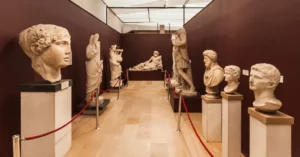AI Answer Evaluation Platform Live Now. Try Free Answer Evaluation Now
Pliocene Epoch
The Pliocene Epoch is a period in Earth’s history that spanned from about 5.3 million to 2.6 million years ago. It is the last epoch of the Neogene Period in the Cenozoic Era, following the Miocene Epoch and preceding the Pleistocene Epoch [1]. The Pliocene was a time of significant climatic change and evolutionary development, setting the stage for the modern world.

Climate and Geography
During the Pliocene, the world’s continents were close to their current positions, and the overall climate was cooler and drier than in previous epochs [2]. However, the climate varied greatly during this time, with periods of warming and cooling.
Climate Change
The Pliocene experienced a series of climatic shifts. Early in the epoch, the global climate was relatively warm, with temperatures about 2-3°C higher than today. However, by the end of the Pliocene, the Earth had entered a period of global cooling, leading to the ice ages of the Pleistocene [3].
Geographic Shifts
The geography of the Pliocene was marked by the continued movement of continents and the formation of the Isthmus of Panama, which connected North and South America. This event had a profound impact on ocean currents, climate, and animal migration [4].
Flora and Fauna
The Pliocene was a time of significant evolutionary change, with many modern groups of plants and animals appearing for the first time.
Flora
The cooling and drying trend of the Pliocene led to the spread of grasslands and the decline of tropical rain forests. This change in vegetation had a significant impact on the evolution of herbivorous mammals, leading to the development of grazers adapted to these new environments [5].
Fauna
The Pliocene saw the rise of many modern mammalian families. Notably, the first hominins, the group of species that includes humans and our closest extinct relatives, appeared during this epoch. Other significant developments include the diversification of marine mammals and the appearance of large, grazing mammals such as horses and elephants.
Notable Events
The Pliocene was marked by several significant events, including:
- The formation of the Isthmus of Panama, which had a profound impact on global climate and biodiversity.
- The evolution of the first hominins, marking the beginning of the human lineage.
- The onset of global cooling, setting the stage for the ice ages of the Pleistocene.
The Impact of the Isthmus of Panama Formation
Ocean Currents and Climate
The formation of the Isthmus of Panama, a narrow strip of land connecting North and South America, was one of the most significant geological events during the Pliocene. This event altered global ocean currents, leading to the Gulf Stream’s intensification, which warms the North Atlantic and influences the climate of North America and Europe.
Biodiversity and The Great American Biotic Interchange
The formation of the Isthmus also triggered the Great American Biotic Interchange, a major exchange of fauna between North and South America. Animals from North America such as saber-toothed cats, horses, and camels migrated south, while South American species like ground sloths and armadillos moved north.
Evolution of Hominins
The Pliocene Epoch is notable for the emergence of the first hominins, marking the beginning of the human lineage. The genus Australopithecus, which includes species like Australopithecus afarensis (famously known as “Lucy”), appeared in the late Pliocene around 4 million years ago. These early hominins exhibited both ape-like and human-like characteristics, indicating a transition towards bipedalism.
The Onset of Global Cooling
The end of the Pliocene marked the beginning of a series of ice ages, a period known as the Pleistocene. This transition was characterized by the expansion of ice sheets in the Northern Hemisphere, a trend driven by changes in Earth’s orbit and tilt, which affected the amount of sunlight reaching the planet’s surface.
Pliocene’s Legacy: A Glimpse into Future Climate?
Interestingly, the Pliocene may offer insights into future climate scenarios. The concentration of carbon dioxide in the atmosphere during the Pliocene was similar to today’s levels, making it a potential analogue for predicting future climate conditions in the context of global warming.
Conclusion
The Pliocene Epoch was a transformative period in Earth’s history, characterized by significant climatic changes and evolutionary developments. From the formation of the Isthmus of Panama to the emergence of the first hominins and the onset of global cooling, the Pliocene set the stage for the world as we know it today.
References
[1] “Pliocene Epoch.” Encyclopædia Britannica. https://www.britannica.com/science/Pliocene-Epoch
[2] “Pliocene Epoch: Climate, Animals, & Plants.” National Geographic Society.
[3] “Pliocene Climate.” University of California Museum of Paleontology. https://ucmp.berkeley.edu/tertiary/pli.html
[4] “The Pliocene Epoch.” Palaeos
[5] “Pliocene Epoch: Climate, Animals, & Plants.” National Geographic Society.
[6] “Pliocene Climate.” University of California Museum of Paleontology. Link




